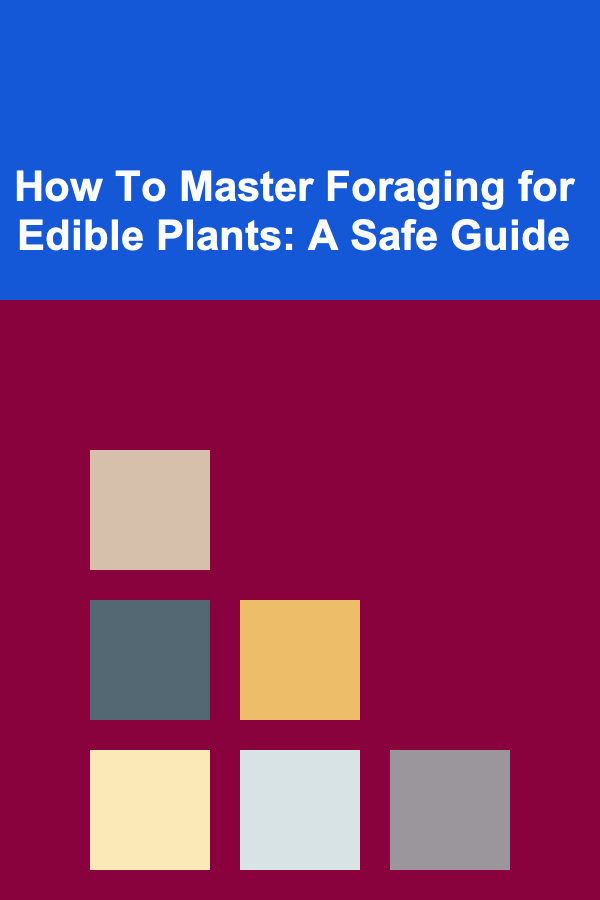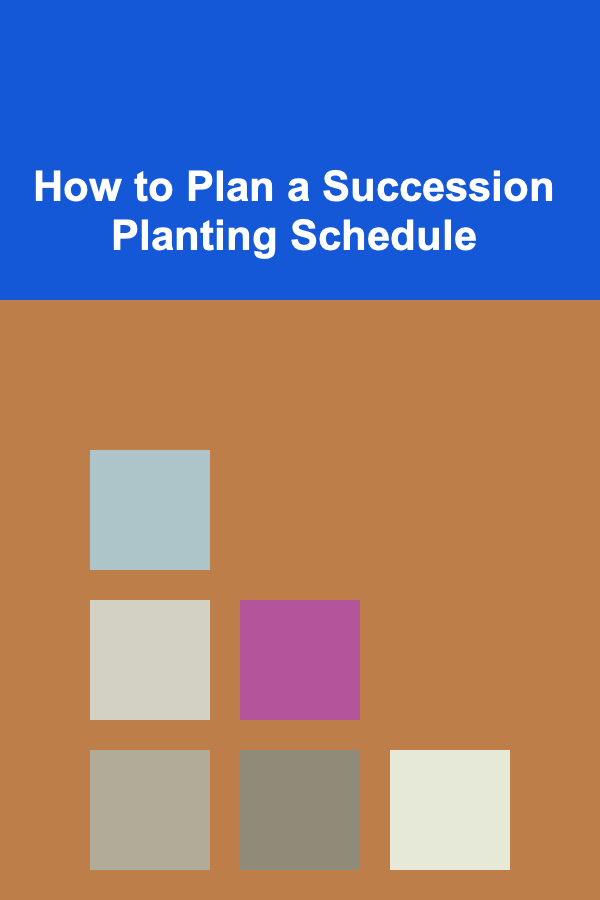
How To Master Foraging for Edible Plants: A Safe Guide
ebook include PDF & Audio bundle (Micro Guide)
$12.99$10.99
Limited Time Offer! Order within the next:

Foraging for edible plants has become an increasingly popular activity in recent years, driven by a desire to reconnect with nature, learn sustainable practices, and reduce food costs. Whether you're hiking in the wilderness, strolling through a park, or even exploring your backyard, knowing how to safely identify and harvest wild edibles can be an incredibly rewarding skill. However, foraging is not without its risks, and it's essential to approach it with caution, respect, and responsibility.
In this comprehensive guide, we will explore the art and science of foraging for edible plants, including essential safety tips, common plants you can find, how to identify them, and how to harvest and prepare them. By the end, you'll have a solid understanding of the fundamentals of foraging and feel confident in your ability to safely enjoy nature's bounty.
Why Forage?
Foraging offers numerous benefits beyond simply sourcing food. Here are a few reasons why more people are getting into this practice:
- Connection with Nature: Foraging fosters a deep connection with the natural world and allows you to appreciate plants and ecosystems on a deeper level.
- Sustainability: By harvesting plants in their natural habitat, foraging promotes sustainability. You are gathering food that is grown naturally without chemical fertilizers, pesticides, or industrial farming methods.
- Health Benefits: Many wild plants are rich in nutrients, vitamins, and minerals that may not be as prevalent in store-bought produce. Some plants also offer medicinal properties.
- Cost-Efficiency: Foraging can help reduce grocery bills, as you are gathering food for free from your environment.
However, the key to reaping these benefits lies in understanding how to forage safely and responsibly.
Safety First: The Basics of Safe Foraging
Before embarking on your foraging adventure, it's essential to understand the risks involved and take appropriate precautions. The most important rule is to never eat a wild plant unless you are 100% certain of its identification. Many plants are toxic, and some can be deadly if consumed. Here's a safe approach to foraging:
1. Learn from Experts
Foraging can be complex and requires knowledge. While there are many resources online, books, and apps to help you identify plants, it's best to start by attending foraging classes or going on guided foraging walks. Learning directly from an experienced forager or botanist will give you invaluable insights and hands-on practice.
2. Use Multiple Identification Sources
Never rely on a single resource to identify a plant. Cross-reference different books, websites, and plant identification apps to confirm your plant identification. Look at multiple features, such as the leaves, flowers, stems, and fruits, and take note of the plant's habitat and growth patterns.
3. Avoid Plants with Similar-Looking Toxic Counterparts
Many edible plants have poisonous look-alikes. For example, the wild carrot (Queen Anne's lace) looks similar to the highly toxic poison hemlock. Learn how to distinguish between these plants. Focus on key differences such as leaf shape, flower structure, and stem texture.
4. Start Small
If you're new to foraging, begin with a few well-known, easily recognizable plants that have minimal look-alikes. Plants such as dandelions, clover, wild garlic, and plantain are great beginner-friendly options.
5. Do a Taste Test
Once you have identified an edible plant, always perform a small taste test before consuming it in large quantities. Even non-toxic plants can cause allergic reactions in some individuals. Chew a small amount and wait for a few hours to check for any adverse reactions.
6. Harvest Responsibly
When foraging, take care not to over-harvest or damage the plant. Never take more than you need, and always leave enough behind for the plant to continue growing and reproducing. Foraging should not harm the ecosystem, and sustainability is key.
7. Avoid Contaminated Areas
Never forage in areas that are likely to be contaminated by pesticides, chemicals, or pollution. Avoid foraging near busy roads, industrial sites, or places where chemicals are likely to be present. Always select plants from clean, wild, natural environments.
8. Be Aware of Local Regulations
Some plants may be protected by local laws and foraging them may be illegal. Always check local regulations before foraging in specific areas, especially in national parks or protected lands.
Essential Tools for Foraging
While foraging doesn't require much equipment, there are a few essential tools that can make the experience safer and more enjoyable:
- A Good Plant Identification Guide: A reliable plant identification book or app is essential for identifying plants correctly.
- A Sharp Knife or Scissors: Use this for cutting plants cleanly, especially when harvesting roots or woody plants.
- Gloves: Some plants, like nettles, can cause skin irritation. Wearing gloves will protect you from contact with such plants.
- A Basket or Bag: A breathable basket or bag allows the plants to stay fresh and prevents them from getting crushed during your hike.
- A Notebook: Keep a foraging journal where you can document the plants you encounter, including the date, location, and any relevant notes. This can help you remember the plant's characteristics and improve your foraging skills over time.
Common Edible Plants to Forage
Here are some of the most common and easiest-to-identify edible plants that you can find in many regions across the world. Remember, the plant's appearance may vary depending on the season and region, so always double-check your identification.
1. Dandelion (Taraxacum officinale)
Dandelions are one of the most well-known and widely found edible plants. Every part of the plant is edible, from the roots to the leaves to the flowers. The leaves can be eaten raw in salads or cooked, while the roots can be roasted and used as a coffee substitute. The flowers are often used to make wine or jelly.
2. Wild Garlic (Allium ursinum)
Also known as ramps, wild garlic is a flavorful herb that grows in damp woodlands. It has broad green leaves and a strong garlic scent. You can use it in a variety of dishes, much like you would use regular garlic or garlic chives.
3. Plantain (Plantago major)
Plantain is a common and nutritious weed that grows in lawns and fields. The leaves can be eaten raw in salads or cooked. Plantain also has medicinal properties and is often used as a poultice for insect bites or minor skin irritations.
4. Clover (Trifolium spp.)
Clover is easy to identify, with its three-lobed leaves and small, round flowers. The leaves can be used in salads, and the flowers can be made into a tea. Clover is rich in protein and other nutrients, making it a valuable wild edible.
5. Nettle (Urtica dioica)
Nettle is a wild plant with stinging hairs on its leaves and stems. However, once the plant is cooked, the sting disappears. Nettle is highly nutritious and can be used in soups, teas, and even pesto.
6. Chickweed (Stellaria media)
Chickweed is a tender, leafy green that grows in gardens, lawns, and fields. It has a mild, slightly sweet flavor and can be eaten raw in salads or used in soups and stews.
7. Purslane (Portulaca oleracea)
Purslane is a succulent plant with fleshy, oval leaves. It has a slightly tangy flavor and is rich in omega-3 fatty acids. It can be eaten raw in salads or cooked.
8. Yarrow (Achillea millefolium)
Yarrow is a wild herb with fern-like leaves and small white or pink flowers. It has a long history of medicinal use and can be used in teas or as a poultice for wounds.
9. Fennel (Foeniculum vulgare)
Fennel is a highly aromatic herb with feathery leaves and a sweet, licorice-like flavor. You can eat the young shoots and leaves raw in salads or cook the bulb, which has a mild, sweet flavor.
10. Mulberry (Morus spp.)
Mulberries are sweet, dark purple or red berries that grow on trees. They are rich in vitamins and antioxidants and can be eaten fresh, dried, or made into jams and jellies.
How to Harvest and Prepare Edible Plants
Foraging is not just about identifying and picking plants, but also about knowing how to harvest them sustainably and prepare them safely.
Harvesting Tips
- Harvesting Leaves: Always pick leaves from the top of the plant, leaving the roots and the rest of the plant intact so it can continue to grow.
- Roots: When harvesting roots, be sure to dig gently to avoid disturbing the soil and other plants. Only take what you need and leave enough for the plant to regenerate.
- Flowers and Fruits: Flowers should be picked in their prime, usually when they are fully open but not yet wilting. Be sure to leave some behind for pollinators and future seed production.
Preparation Tips
- Wash Thoroughly: Always wash your foraged plants thoroughly to remove dirt, insects, or potential pesticides.
- Cooking: Many wild plants are edible raw, but others, like nettles, require cooking to neutralize their stinging properties.
- Preservation: Some plants, like dandelion roots or mulberries, can be preserved by drying or making jams, jellies, or syrups.
Conclusion
Mastering the art of foraging for edible plants is a rewarding skill that allows you to connect with nature, expand your culinary horizons, and live more sustainably. By learning to identify wild edibles, practicing safety and responsibility, and using the right tools and techniques, you can enjoy nature's bounty in a safe and enjoyable way. Remember to always start slow, learn from experts, and respect nature's delicate balance as you embark on your foraging journey. Happy foraging!

How to Create a Checklist for Evaluating the Legal and Regulatory Aspects of Partnership Agreements
Read More
How to Create a Family Art Gallery with Homemade Projects
Read More
How to Create the Illusion of More Space in a Tiny Apartment
Read More
How to Insulate Your Home Against Sound and Heat Simultaneously
Read More
How to Make Money Online as a YouTuber: 10 Actionable Ideas
Read More
How to Plan a Succession Planting Schedule
Read MoreOther Products

How to Create a Checklist for Evaluating the Legal and Regulatory Aspects of Partnership Agreements
Read More
How to Create a Family Art Gallery with Homemade Projects
Read More
How to Create the Illusion of More Space in a Tiny Apartment
Read More
How to Insulate Your Home Against Sound and Heat Simultaneously
Read More
How to Make Money Online as a YouTuber: 10 Actionable Ideas
Read More